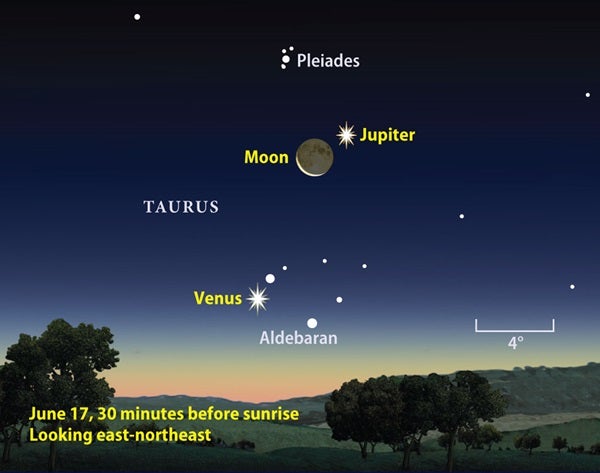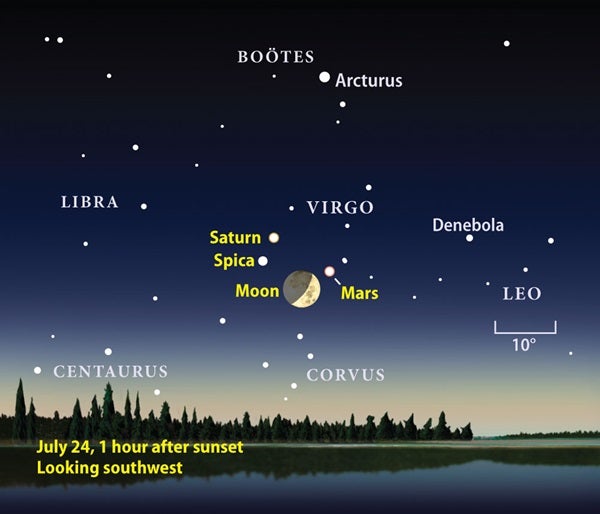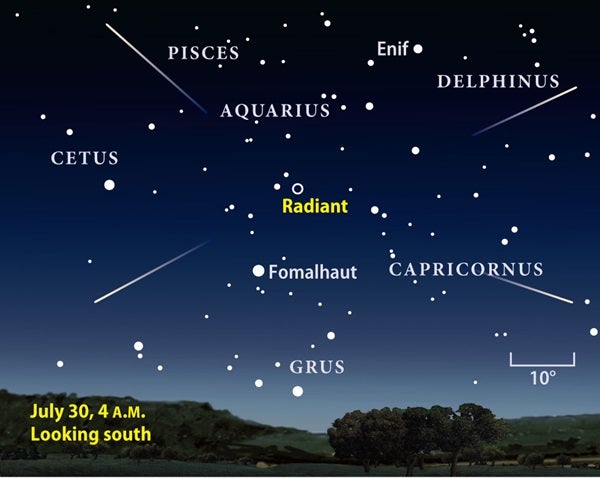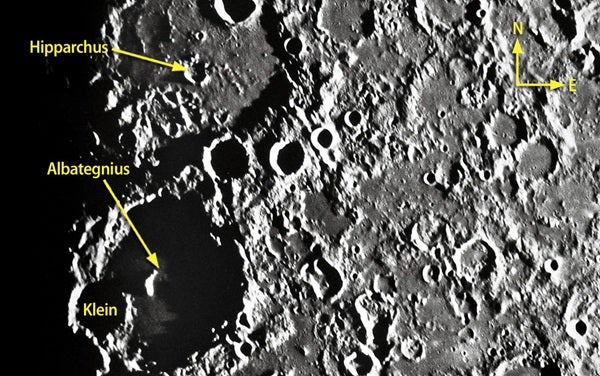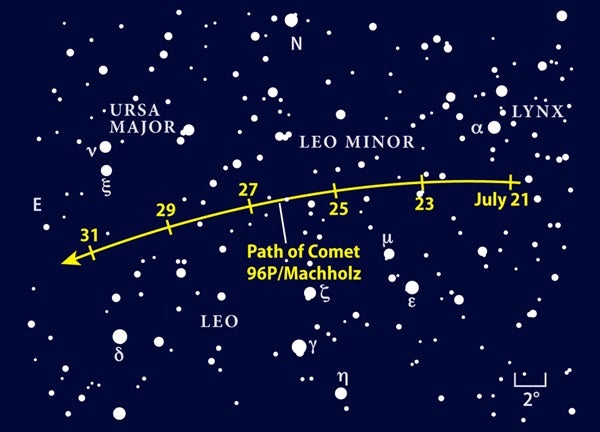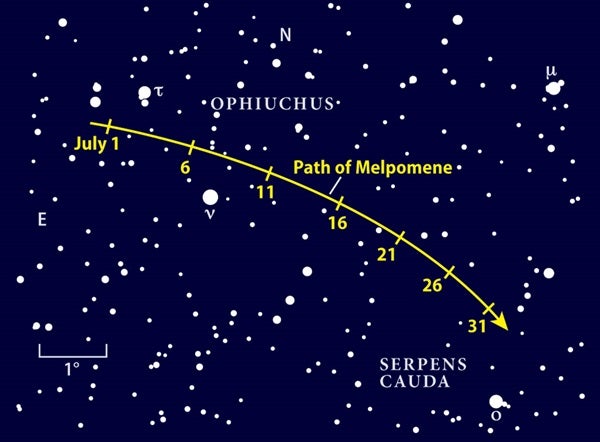The morning sky displays a pair of planets that appears even more spectacular. Both Venus and Jupiter shine brilliantly before dawn near the impressive Pleiades and Hyades star clusters. You won’t want to miss the waning crescent Moon’s passage through this region in mid-July.
Our sky tour begins in evening twilight as the door to July opens. Although Mercury reached its greatest elongation from the Sun on the evening of June 30, it remains conspicuous in early July. On the 1st, it lies 10° high in the west-northwest 30 minutes after sunset. It doesn’t set until an hour later.
The Sun-hugging planet shines at magnitude 0.4, which is plenty bright enough to see with naked eyes against the twilight glow. If you can’t spot it right away, binoculars will bring it into view. Mercury dims noticeably after the 1st, however. One week later, it glows at magnitude 1.0, a drop in brightness of more than 40 percent. The inner world disappears in the Sun’s glare by mid-July.
Mercury’s appearance through a telescope evolves from night to night. On the 1st, the planet appears 8.1″ across and 41 percent illuminated. By the 8th, the disk’s diameter has grown to 9.4″ while its crescent phase has dwindled to 27 percent lit.
Shift your gaze to the southwestern sky as darkness falls, and you can’t miss a trio of 1st-magnitude objects: Mars, Saturn, and Spica. Mars appears farthest to the west, but it makes a beeline toward the other two as July progresses.
On the 1st, the Red Planet shines at magnitude 0.9 and lies 2° southeast of 4th-magnitude Beta (β) Virginis. Earth’s planetary neighbor drifts steadily eastward against the backdrop of Virgo the Maiden, passing 1° south of 4th-magnitude Eta (η) Vir on July 13 and 3° south of 3rd-magnitude Gamma (γ) Vir on July 23.
Use binoculars to get a good sense of these objects’ colors. Mars’ distinct orange-red hue contrasts beautifully with blue-white Spica, while Saturn glows a subtle shade of yellow.
Observers who target Mars through a telescope likely will be disappointed. The planet’s tiny disk measures just 6″ across at midmonth and shows little, if any, detail.
After a quick look, slew over to magnitude 0.7 Saturn. A telescopic view of the ringed planet never fails to impress. Its globe measures 17″ across the equator, nearly three times Mars’ apparent diameter. But it’s the necklace of untold billions of icy particles, orchestrated by gravity into a spectacular ring system, that creates the planet’s visual appeal. The rings span 39″ in mid-July and tilt 13° to our line of sight. Any telescope reveals the dark Cassini Division that separates the outer A ring from the brighter B ring.
Spying some of Saturn’s moons is almost as easy. The brightest one, 8th-magnitude Titan, orbits the planet every 16 days. Small scopes show it if you know where to look. This moon passes south of Saturn July 7 and 23 and north of the planet July 15 and 31.
The month’s final evening is also a good time to search for Iapetus. On the same date Titan lies 0.7′ north of Saturn, Iapetus resides 2.5′ north-northwest of the planet. The more distant moon then glows at 11th magnitude, roughly 10 percent as bright as Titan.
That same evening, a trio of 10th-magnitude moons hovers much closer to the planet. Dione also lies west of Saturn, at a distance of 0.8′, while Tethys and Rhea appear to the planet’s east (0.6′ and 1.3′ away, respectively). These moons orbit Saturn much faster than Titan or Iapetus and change position noticeably from one night to the next.
This month is a great time to track down Pluto. Not only does it ride high in the late-evening sky, but it also skirts the southern edge of the bright open star cluster M25 in Sagittarius. During the second half of July, the dwarf planet passes 0.3° south of M25’s crowded core. The 5th-magnitude cluster shines brightly enough to see with naked eyes and looks splendid through binoculars.
You’ll need a telescope to spot Pluto, however. The 14th-magnitude object won’t show up visually in anything less than a 6-inch scope, and you’ll need near-perfect observing conditions to spot it with that aperture. A 10-inch or larger scope makes the task much easier. Sketch the star field around the distant world’s position marked on the finder chart on the opposite page, then return to the same field a night or two later. The object that moved is Pluto.
A waxing gibbous Moon interferes with Pluto-viewing during July’s final week, particularly on the 29th and 30th when it lies less than 10° away. Although Pluto remains visible nearly all night, the best time to search for it is when Sagittarius climbs highest above the southern horizon around midnight local daylight time.
Neptune rises in late evening along with the background stars of Aquarius the Water-bearer. The 8th-magnitude planet appears highest in the south around 4 a.m. local daylight time in mid-July. To find it, grab your binoculars and center them on 4th-magnitude Theta (θ) Aquarii. The planet will be in the same field of view, just 3.4° south of the star. (A 5th-magnitude star, 42 Aqr, lies half that distance south of Neptune.) A telescope reveals the planet’s 2.3″-diameter disk and subtle blue-gray color.
Some 35° east-northeast of Neptune resides its sibling, Uranus. This planet rises around midnight local daylight time and by the onset of twilight has climbed halfway to the zenith in the southeast. It lies within the confines of Cetus the Whale, near that constellation’s border with Pisces the Fish.
You certainly won’t want to miss this month’s predawn sky. On July 1, a dramatic group of celestial objects greets early risers. Venus and Jupiter stand 4.8° apart against a backdrop that includes the bright Pleiades and Hyades star clusters. Rising first, just after 2:30 a.m. local daylight time, the Pleiades (M45) shows up initially as a misty glow. It resolves into individual stars once it climbs a few degrees. Jupiter pokes above the east-northeastern horizon about 40 minutes later, followed by Venus a half-hour after that.
Venus lies within the confines of the V-shaped Hyades. Taurus’ brightest star, Aldebaran (which appears to be a cluster member but actually is a foreground object), rises 15 minutes after Venus. The spectacular string of objects covers a 14° vertical span. Venus shines at magnitude –4.6 — 11 times brighter than Jupiter (magnitude –2.0) and 160 times brighter than Aldebaran (magnitude 0.9).
Although the two planets move apart as July progresses and shift positions relative to the starry background, the morning scene remains mesmerizing. Venus lingers within the Hyades until July 9, when the planet passes 0.9° north of Aldebaran. (By then, our neighbor has brightened slightly, to magnitude –4.7.)
A beautiful waning crescent Moon joins the group in mid-July. On the 14th, our satellite stands 4° south of M45. The following morning, the Moon and planets form a spectacular triangle, with the Moon 4° east of Jupiter and the same distance northwest of Venus.
Naked eyes and binoculars will deliver unforgettable views of July’s changing predawn vista. But you’ll also want to target the planets through a telescope. A close-up view of Venus shows rapid changes. On the 1st, the brilliant planet’s disk appears 45″ across and 16 percent lit. By the time the Moon passes by at midmonth, Venus’ crescent phase has waxed to 29 percent illumination, and its diameter has shrunk to 36″. And as July concludes, the planet’s disk spans 28″ and appears 41 percent lit.
In contrast, Jupiter hardly varies. The giant planet’s diameter grows a mere 6 percent during July, from 34″ to 36″. This world’s massive atmosphere organizes itself into an alternating series of parallel dark belts and lighter zones. Finer details emerge on mornings with good seeing.
Meteor observers should keep their eyes peeled during July’s second half. First, the Moon largely avoids the best viewing before dawn. And although the Perseid shower doesn’t peak until August, its slow buildup provides a significant number of late-July meteors.
It’s not the only source, however. Both the Alpha Capricornid and Southern Delta Aquarid showers peak the night of July 29/30, and they begin a couple of weeks earlier. On the morning of the 30th, the waxing gibbous Moon sets around 3 a.m. local daylight time, leaving an hour of dark sky before twilight commences.
The Alpha Capricornids produce five meteors per hour under optimal conditions while the Southern Delta Aquarids generate three to four times as many. These meteors radiate from the southern constellations Capricornus and Aquarius, respectively, while the competing Perseids emanate from Perseus in the northeast.
Viewing the Moon repeatedly is not a sign of some weird astronomical form of obsessive-compulsive disorder. Lunar observers target Earth’s satellite through their telescopes frequently because its appearance changes. The play of light and shadow can transform the eyepiece view in just a few hours. A low-profile crater may appear conspicuous one evening, but the higher Sun angle the following day can render it almost invisible.
To see a good example of this changing perspective, aim your scope along the terminator — the dividing line between day and night on the lunar surface — the evening of First Quarter Moon on July 25 (although first take a moment to admire the pretty triangle of Mars, Saturn, and Spica to the Moon’s right). Two large craters stand out just south of the lunar equator. The rugged southern one, 85-mile-wide Albategnius, got its name from Arabian astronomer and prince al-Battani, who lived in the late ninth to early 10th centuries. The earring-like crater Klein lies on Albategnius’ southwestern edge.
Hipparchus lies just to the north. The highly battered rim of this 93-mile-wide crater testifies to its greater age. Also note the many features on its lava-flooded floor compared with the smoother central plains of Albategnius. Hipparchus nearly disappears from view in just a few nights, unlike the fame of the Greek astronomer it is named for, who compiled the first star catalog in the second century B.C.
| When to view the planets | ||
| EVENING SKY | MIDNIGHT | MORNING SKY |
| Mercury (west) | Saturn (west) | Venus (east) |
| Mars (southwest) | Uranus (east) | Jupiter (east) |
| Saturn (southeast) | Neptune (southeast) | Uranus (southeast) |
| Neptune (south) | ||
You’ll want to keep binoculars handy and stay plugged in to the Internet for Comet 96P/Machholz. If predictions hold, we could be treated to a 7th-magnitude streak hanging low in the evening sky during late July. Just remember that the brightness of a comet is notoriously difficult to forecast.
California amateur astronomer Donald Machholz discovered the comet in May 1986. This ages-old ball of ice and dust has a period of 5.3 years and approaches within 11.5 million miles of the Sun — the closest of any known periodic comet. A relatively close pass by Jupiter in 2008 nudged the comet’s orbit so that it now comes slightly closer to the Sun but takes about two weeks longer to complete a circuit.
Our first glimpse of the comet should come July 12 or 13. But don’t look for it in the sky. The comet is then near its closest point to the Sun (which comes on the 14th) and will be lost in our star’s glare. Instead, look for it on the website of the Solar and Heliospheric Observatory at http://sohowww.nascom.nasa.gov/data/realtime-images. The observatory’s wide-field coronagraph (LASCO C3) returns images of the Sun’s vicinity (with our star blocked out) in near real time. The instrument will capture the comet’s passage for three or four days.
Machholz then moves into the evening sky, where it could show up low in the northwest as early as July 21. It spends the rest of the month sliding eastward through Leo and Leo Minor as it fades. It may dim to 10th magnitude by July’s close, wrapping up a brief but potentially exciting appearance.
Asteroid 18 Melpomene spends the month wandering back and forth between Serpens Cauda and Ophiuchus. It crosses the border between these two constellations three times in July — and will do so once more August 2. This region lies about halfway to the zenith in the southern sky during late evening.
Thanks to obscuring dust and cold gas in this section of the Milky Way, the stars behind Melpomene’s path are fewer and fainter than the asteroid experienced during the past few months. That makes it easier to spot the 86-mile-wide space rock, which fades from 9th to 10th magnitude during July. Still, you’ll need a 4-inch telescope to spot it if you observe from the suburbs.
Avoid searching for the asteroid on the month’s first few nights to allow the bright Moon to leave the area. Any evening between July 5 and 11 should be a good time. Melpomene then lies less than 1° from 3rd-magnitude Nu (ν) Ophiuchi, which makes an excellent guide star. You should be able to identify the asteroid by comparing the view in your eyepiece to the finder chart at right.
Martin Ratcliffe provides professional planetarium development for Sky-Skan, Inc. Alister Ling is a meterologist for Environment Canada.

